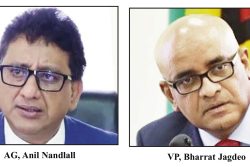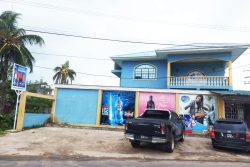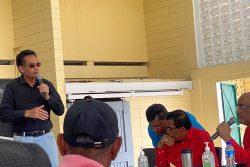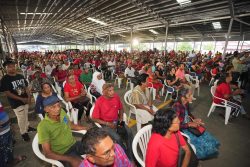Infrastructural failures in this country have almost entered the realm of myth. They are so numerous, so egregious, so pervasive that it is hard to believe that they are not the stuff of legend rather than a reflection of what is happening on the ground. It would be easy to imagine that we were in some kind of video-game world, where malevolent avatars caused bridges to collapse, roads to disappear, conservancy dams to breach, sea walls to rupture, kokers to perforate, drains to remain clogged and public edifices to become unsteady. But this is not virtual reality; it is reality.
Yet the record of crumbling installations of one kind or another produces no reaction from those who sit in government over us. How is it, one wonders, that nobody in the corridors of power appears to harbour even a tinge of embarrassment, unease or concern about the litany of structural disasters of the last seventeen or so years, let alone display any exasperation – or god forbid, anger. (Unless there is blame to be apportioned, that is.) No one over the years has said to the taxpayers who have funded these bungles great and small, that this incompetence/and or corruption would stop, and that measures would be put in place to see that it did. It is as if the powers that be are beyond not just embarrassment, but a sense of scandal. Nothing offends them any longer – except the critics, of course.
There was the Prime Minister last week telling the public in a letter to this newspaper, that heavy rains wash away the best of structures all over the world. Well yes, but not every time there is heavy rain and not every year. He was writing in relation to a report in this newspaper concerning roads washing away in Region Nine. Most of the problem infrastructure that the public knows about is along the coastland, with Region Four being particularly well reported partly because it is more densely populated than other regions, is especially low-lying and has more infrastructure of one kind or another than elsewhere.
But interior regions which are not in the public eye to the same degree as the littoral have their own infrastructural woes. Region Nine, referred to above, which is supposed to be a hub in terms of the connection with Brazil, has been particularly unfortunate. It is true, of course, that distances there are vast, communities are widely dispersed and the numerous creeks and rivers are prone to flood in the rainy season. In a general sense, in fact, weather conditions are more extreme than they are on the coast. But is that any reason, one might ask, why infrastructural work should be inferior? What is the point of wasting taxpayers’ money doing the same thing over and over again when it has been demonstrated to have failed?
As we reported recently, such is the case with the road from Lethem to the Deep South, which washed away not just this year but last year as well in the rainy season, both because culverts were not built which should have been, and because the contractor used the dust at the side of the trail as a foundation, on which laterite was then superimposed. We were told that earlier work undertaken by the District Toshaos Council in some portions had endured; clearly they had a much better idea of what they were doing. One resident told this newspaper that the contractor did not understand the geography of the area and how the water flowed. This informant suggested that the contractor really needed to go and see what happened in the rainy season, and one can only observe that if he didn’t do that, he obviously was not doing a serious job. The other criticism we heard was that the upgraded trails did not cater for heavy-duty vehicles, a major drawback, one would have thought, in an area like the Rupununi.
It is not just upgraded roads which have been doing a disappearing act, but new bridges have been damaged or collapsed or have not been completed. The most prominent example is the Rupununi Bridge near Katooranib, the middle section of which went subterranean in 2008 after a 35-tonne excavator attempted to cross it. It cost $16M to build, and it still hasn’t been fixed yet. The background to this fiasco has never been explained to the public. For example, did the bridge have weight restrictions? If it did, were those clearly posted, and if they were, has the owner of the excavator agreed to pay compensation to the regional authorities, and if he hasn’t, have they moved to recover the money?
There was too the half repaired bridge at Moco Moco in 2008, where work had ceased because the contract had been underestimated. The estimates had included the re-use of existing planks, but when the old bridge was dismantled, these were found to be unusable. As a consequence large gaps were left in the decking that year through which people and animals fell; all survived except for one man, who hit his head on a bolt before falling into the water. In December 2008, this newspaper was told at Karasabai that in addition to poor roads there, three bridges had been washed away in the course of the previous two years.
As for this year, our reporter saw one bridge washed away in the south, and one partly burnt. In addition the approaches to some bridges on the road from Lethem to Karaudarnau had not been done properly. The infrastructural disaster which dwarfs them all, of course, is the Moco Moco hydro-electric facility built by the Chinese, which fell victim to a landslide.
With respect to the roads specifically, the Prime Minister in his letter last week wrote that “Two-lane roads, natural surface to asphaltic concrete across Guyana would cost from G$5 million to G$200 million per mile…” He went on to say in essence that the Ministry of Works did what it could with the money, expertise and materials available to it. One can only enquire whether roads with a dust foundation make any economic sense at all, when they cannot withstand the rainy season, and as mentioned above, the Toshaos had demonstrated that they could do a better job.
Various correspondents to this newspaper have pointed out that Brazil, which confronts similar road-building challenges on the other side of the Takutu to those found in the Rupununi, has infrastructure – particularly roads – of a much higher quality than ours. Do the authorities know how much their roads cost, and whether that standard would be prohibitive for us? One letter writer a couple of years ago said in this newspaper that the Brazilians utilized laterite as a foundation material on their roads, and asked why we could not do the same. Has anyone in authority ever attempted to inquire into what they are doing right and we are doing wrong, or what the possibilities are for relatively durable roads in this region? Most of all, have they ever asked the local people for their input?
As it is, too much taxpayers’ money is being washed away in the Rupununi, and there needs to be some level of investigation as to why that is so. Everything from the tendering procedures, to the contractors who are awarded the projects, to the conception and design of the works need to be looked at. The public wants some answers, particularly that segment which lives in Region Nine.









